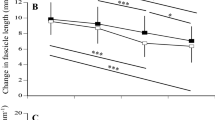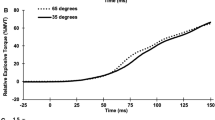Summary
The locust jumps by a rapid extension of its metathoracic tibiae. The comparatively slow rate of rise of tension of the extensor tibia muscle means that if it is to shorten rapidly, it must develop tension isometrically prior to the jump by co-contracting with the flexor muscle. The extensor muscle is far stronger than the flexor and thus there has to be considerable structural specialisation of the joint to enable the flexor to prevent the tibia moving under the extensor tension. The geometry of the joint gives the flexor muscle a very large mechanical advantage over the extensor in the fully flexed position. This mechanical advantage decreases rapidly as the joint extends so that the residual flexor tension does not slow down the movement (Fig. 4). There is also a locking device associated with the flexor tendon which is engaged when the tibia is fully flexed and which holds it in this position against the developing extensor force (Fig. 5).
Similar content being viewed by others
References
Bennet-Clark, H. C., Lucey, E. C. A.: The jump of the flea: a study of the energetics and a model of the mechanism. J. exp. Biol.47, 59–76 (1967)
Brown, R. H. J.: Jumping Arthropods. Times Sci. Rev.48, 6–7 (1963)
Brown, R. H. J.: Mechanism of locust jumping. Nature (Lond.)214, 939 (1967)
Burrows, M.: The mechanics and neural control of the prey capture strike in the Mantid ShrimpsSquilla andHemisquilla. Z. vergl. Physiol.62, 361–381 (1969)
Burrows, M., Horridge, G. A.: The organisation of inputs to motoneurons of the locust metathoracic leg. Phil. Trans. R. Soc. Ser. B (in press)
Godden, D. H.: The neural basis of locust jumping. Amer. Zool.9, 1139–1140 (1969)
Hoyle, G.: Neuromuscular mechanisms of a locust skeletal muscle. Proc. roy. Soc. B143, 343–367 (1955)
Hoyle, G., Burrows, M.: Neuromuscular mechanisms underlying behaviour in the locustSchistocerca gregaria. I. Physiology of identified motoneurons in the metathoracic ganglion. J. Neurobiol.4, 3–41 (1973)
Sandeman, D. C.: A sensitive position measuring device for biological systems. Comp. Biochem. Physiol.24, 635–638 (1968)
Snodgrass, R. E.: Principles of insect morphology. New York: McGraw-Hill 1935
Roberts, A.: Recurrent inhibition in the giant-fibre system of the crayfish and its effect on the excitability of the escape response. J. exp. Biol.48, 545–567 (1968)
Rothschild, M., Schiein, Y., Parker, K., Sternberg, S.: Jump of the oriental rat fleaXenopsylla cheopis (Roths). Nature (Lond.)239, 45–48 (1972)
Author information
Authors and Affiliations
Additional information
I would like to thank Dr. M. Burrows for much helpful advice and encouragement. This work has been supported by an S.R.C. studentship.
Rights and permissions
About this article
Cite this article
Heitler, W.J. The locust jump. J. Comp. Physiol. 89, 93–104 (1974). https://doi.org/10.1007/BF00696166
Received:
Issue Date:
DOI: https://doi.org/10.1007/BF00696166




